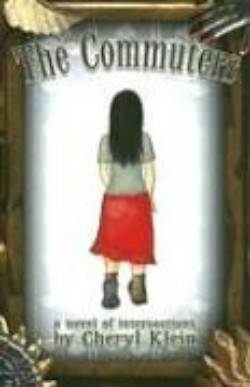The Commuters
A Novel of Intersections
Written with bold authority, this book teases the reader, sliding effortlessly from deep inside each character up to a soaring bird’s-eye commentary on life spent in transit. At its heart is the tale of an assembly of foster children and the intersection of their lives with both gritty reality and the golden dance of people who were “not meant to partake in a life of the alleyways.” Klein swoops in for a sip of the existence of an undocumented single mother working in a sweat shop, alights briefly on the lesbian wife of a wealthy female television producer, and swirls over and around the owner of a café on the rim of the Silver Lake art colony, but always comes back again to one of the foster children.
The novel is punctuated by poetry written by some of the kids in the perfect voice of pre-teens: “I’m nine between two brothers: one fat, one skinny, both mean,” yet the author’s own voice glides throughout the book, a silver thread binding harsh reality. One of the foster children, “a huge, hurt beast bleeding in the middle of a tiny city,” sets fires, and the experience of his arson is told in sharp, visceral accounts. Each fire he sets is “a loop of orange brilliance in the everything-black of night.” An unflinching spotlight shines on the undocumented mother, revealing the drudgery and panic of work hidden from the law: “fingers slashed and stabbed, needles grooving skin like a record.” Yet Klein suffuses the woman’s story with magic, through the letters she writes home: “Los Angeles is beautiful in the winter. The air seems surprised by itself.”
At every turn, the author has a surprise for her readers. Eamon, a history major at Loyola Marymount, visits his girlfriend Zrinka “on the top floor of a former fish-packing plant” and has a surreal late-night encounter with the teen son of the undocumented mother, when the boy leans in and kisses Eamon: “It was exactly the same and exactly different from kissing Zrinka.” Chapters later, Eamon reappears, plunging deep into the “spider sex” of postmodern bisexual relationships, “three of us bunched in a row, giggling, our naked butts in the air,” yet Klein follows this chapter with a cartoon of a young man in his car, commuting from one hill in Los Angeles to another. It is more than a cartoon, of course; it is a graphic novel in itself, in which the author states, “He could fly, but the air gets cold at night over the chaparral.”
It is no surprise, however, that the author is the winner of the nationwide Ben Reitman prize, and has a number of short stories in literary journals such as Blithe House Quarterly. In this novel, each chapter is a story in itself, yet all are pieced together seamlessly, creating a terrain in which life is simply lived, wherever or whatever the circumstance, or the cost.
Even life at its most desperate is unapologetic. When a lover of one of the foster children is confronted and asked the whereabouts of his girlfriend, he has nothing to offer: “Survival had taken up all the space inside him.” He stumbles away, crossing a street where traffic soon conceals his form in the highways that define Los Angeles. A black actress muses about time spent driving to auditions or to the “temp” jobs that support her: “I composed love songs to my Thomas Guide, and a breakup song after one unfortunate incident on 5. I mean the 5. The freeways were self-important like that.” The teen son of the undocumented mother has different view: “There’s something about car rides. You both face forward and things come out of you that might stay buried if you had a pair of eyes to answer to.”
Still, most people use the freeways to hide. They take the 110, slithering past South Central Los Angeles and when “given the option, they would seal themselves in vehicles that resembled army tanks, turn up the radio and condition the air.” This book does the opposite, stripping Los Angeles to its essentials but spinning a golden web across its freeways and alleys, leaving the reader in breathless wonder.
Reviewed by
Carol Lynn Stewart
Disclosure: This article is not an endorsement, but a review. The publisher of this book provided free copies of the book to have their book reviewed by a professional reviewer. No fee was paid by the publisher for this review. Foreword Reviews only recommends books that we love. Foreword Magazine, Inc. is disclosing this in accordance with the Federal Trade Commission’s 16 CFR, Part 255.

